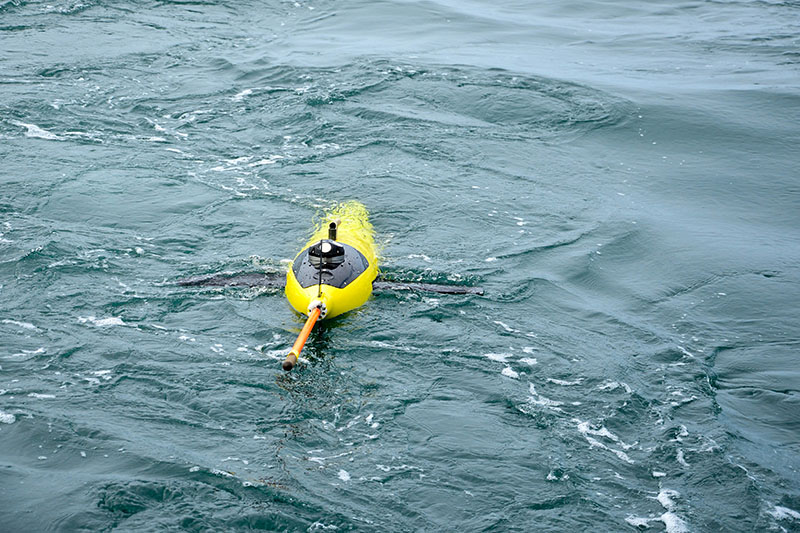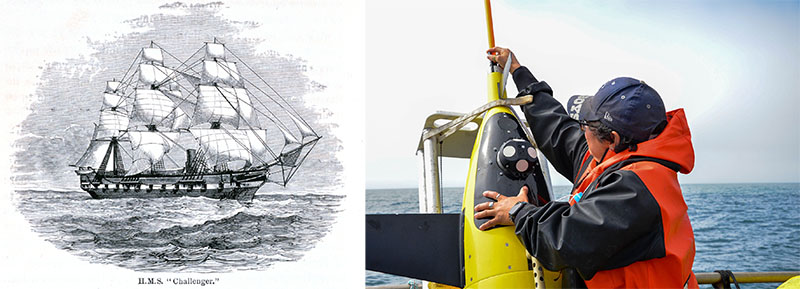
Patricia Albano, NOAA Ocean Exploration
Geoff Shilling, University of Washington Applied Physics Lab
Wu-Jung Lee, University of Washington Applied Physics Lab
When someone says “ocean exploration,” images of sailors braving the high seas in traditional ships may come to mind. While the history of ocean exploration may feature such scenes, modern ocean exploration looks vastly different. Today’s explorers employ the latest tools and technologies to make observations and collect data from hard-to-reach places like the seafloor and water column. Much of what we know about the ocean today comes from expeditions that rely on ships to collect data on the biological, physical, and chemical characteristics of the ocean. However, this approach is constrained spatially, financially, and logistically, impacting our ability to collect critical data about these important ecosystems. In response, researchers are using creative technologies to enable more efficient exploration methods.
Autonomous underwater vehicles (AUVs) are underwater robots that allow scientists to take a different approach and even explore the ocean from shore. Unlike remotely operated vehicles (ROVs) that are connected to a ship via tether cables, AUVs are independent and can be piloted from shore or can follow predetermined courses. After deployment, researchers are free to return to shore while the AUV does the heavy lifting: collecting data that is transmitted when the vehicle’s antenna breaks the water’s surface or is logged and accessed when the AUV is recovered. This gives scientists the flexibility to work on other research objectives while the AUV flies underwater. With their relatively lightweight designs, comparatively lower price tags, and ability to operate independently, AUVs are a dynamic tool that scientists can use in conjunction with ship-based methodologies.
Although the first AUVs came online in the 1950s, the advent of low-power GPS in the mid-1990s and satellite communication systems in the late 1990s ushered in a new era of ocean exploration. Leveraging these capabilities, researchers are now customizing these vehicles to meet specific data collection needs. Currently, a team from the University of Washington Applied Physics Lab is using Seagliders, a type of AUV, to collect data for the development of new acoustics-based exploration methods that will permit large-scale observation of organisms occupying the mid levels of the ocean food web. By outfitting Seagliders with acoustic Doppler current profilers (ADCPs), the team is ground-truthing the utility of AUVs for the collection of biological data that typically requires a ship-mounted or moored echosounder. Each time the Seaglider breaks the water’s surface after a dive (Figure 1), it sends its data to shore-side scientists who can analyze it and do status checks on the glider’s health and location using this portal .

Figure 1: Seaglider is deployed in the waters offshore La Push, Washington. Its orange antenna allows it to communicate with on-shore scientists each time it breaks the surface. After a dive, Seaglider communicates with satellites and sends a text message to the researchers’ phones, letting them know it will be transmitting data and giving them a status check on the glider’s health! Image courtesy of Coordinated Simultaneous Physical-Biological Sampling Using ADCP-Equipped Ocean Gliders. Download largest version (jpg, 3.4 MB).
From the classic sailboats of the past to underwater robots that deliver data to shore-side scientists, it is astounding how ocean exploration has evolved with technological advances. Although ship-based data collection will always play an important role in ocean exploration, technologies like Seagliders afford an unparalleled capacity to explore our planet’s last frontier.

Figure 2: The past and present of ocean exploration. (Left) The HMS Challenger was a late 1800’s research vessel that made many of the discoveries that laid the foundation for ocean science. (Right) Engineer Christina Ramirez affixes Seaglider’s antenna which will allow the glider to communicate with her and other scientists on-shore. Left image courtesy of NOAA Photo Library; right image courtesy of Coordinated Simultaneous Physical-Biological Sampling Using ADCP-Equipped Ocean Gliders. Download largest version (jpg, 3.3 MB).
Published September 7, 2021